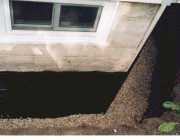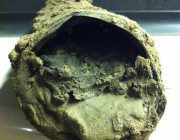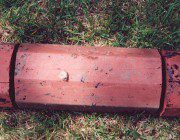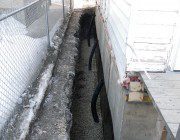WEEPING TILE INSTALLATION & REPAIR IN EDMONTON & AREA

Abarent performs code-compliant weeping tile installations and weeping tile replacements in Edmonton. Building code-compliant installations ensure optimal foundation performance.
Abarent Construction keeps Edmonton foundations safe by installing weeping tiles that move water away from your home and prevent structural damage.
A thorough inspection by our experienced estimator will verify your weeping tile system’s functionality, providing peace of mind and reliable protection for your home.
HOW IS A WEEPING TILE INSTALLED?
Weeping tile installation can be accomplished by ensuring safe excavation using either manual digging techniques or a mini excavator machine. To comply with building code regulations and ensure proper waterproofing, a minimum of 6 inches of clean drainage stone is mandatory in weeping tile installation. However, we believe in going beyond the standard requirements by installing a greater depth of clean drainage stone; this not only enhances the sediment filtration process but also provides improved water drainage for your home’s foundation structure.
Understanding Weeping Tile and French Drain Differences and Solutions
The water drainage of weeping tile, a perforated pipe system installed around your foundation perimeter, may vary depending on the local municipality, and it can either be directed towards a sump pump system or storm sewer system. It’s important to note that weeping tile and French drain are not interchangeable terms: a French drain is installed just below the ground surface to direct surface water to a specific location, whereas weeping tile is laid adjacent to a foundation’s footing to manage groundwater. At Abarent, we have successfully resolved numerous weeping tile problems, including pipe collapse, sediment blockage issues, and improper installation angles, making us a good choice for weeping tile installation services in Edmonton area.
HOW TO REPLACE AN EXISTING DRAIN
Weeping tile systems can become clogged due to high sediment and sand content in the soil, which is why quality Edmonton installation services are crucial for long-lasting performance.
Abarent Construction installs weeping tile systems around Edmonton homes to create proper drainage that stops water damage before it happens.
Homeowners should watch for signs of dysfunctional weeping tile or their absence, such as efflorescence on the basement floor or up the base of the wall, which can indicate inadequate basement moisture control.
When weeping tile becomes dysfunctional, it needs to be addressed immediately to prevent further damage and problems.
Steps to replace existing weeping tile:
- Excavation of the soil around the foundation wall
- Removal of the old weeping tile
- Inspection of the wall for any signs of cracks or damage
- Laying down crushed stone for trench drainage
- Installation of new weeping tile
- Backfilling the trench with clean stone
- Covering the new weeping tile with soil
- Grading newly laid soil away from the foundation
Abarent Construction Employs Advanced Weeping Tile Installation Techniques
We emphasize the importance of proper care during excavation and removal to prevent damage to the foundation walls, using advanced excavation techniques to protect your home’s structural integrity.
This showcases our commitment to quality repair services in Edmonton.
Installation procedures must be strictly followed, including the use of correct stone, filter fabrics, and/or weeping tile sock to prevent sediment buildup, blockage, and loss of drainage.
HOW TO PREVENT ISSUES
Even when weeping tile is installed following Building Code requirements, there may still be future issues if the soil has high fine sediment content, which is why proper groundwater management is crucial in our weeping tile system installation process.
These sediments could lead to blockage.
Abarent Construction Delivers Expert Weeping Tile Installation Services
Our engineering team uses proven installation methods to make sure your weeping tile system protects your home for many years.
Our experience allows us to determine and recommend measures to protect the weeping tile system from future collapse and/or sediment blockage issues, ensuring effective soil erosion prevention and long-lasting performance.
During weeping tile installation, we look for every possibility of how a failure can occur and how to prevent it. We ensure the repair project is done right the first time.
WHAT DOES A WEEPING TILE REPAIR COST IN EDMONTON?
Weeping tile installations and/or replacement projects range from $2000 to $30000 or more, with the installation cost varying based on project complexity and scope.
There are a lot of factors in determining the price. A proper evaluation from one of our experienced estimators is the first step to determining scope and budget.
We like to perform our work efficiently and send out a properly sized crew for each project, ensuring optimal perimeter drainage installation for your property.
This ensures fast and high-quality weeping tile services in Edmonton.
Most weeping tile system and foundation repair projects can be completed in 3 to 7 days.
Abarent Construction Provides Professional Expertise in Weeping Tile Installation and Foundation Repairs
Abarent Construction experts inspect your current weeping tile system and provide reliable repairs that solve drainage problems around your Edmonton property.
Weeping tile installation and foundation repairs are not DIY projects, as they require expertise in hydrostatic pressure relief and other specialized techniques to ensure proper functionality.
There are safety implications when excavating, and experience is required to determine the proper mode of remediation. Application of the proper repair products and membranes should only be done by trained and experienced professionals. An incorrectly completed project could lead to further, more costly issues.
Key Takeaways
- Weeping tile systems protect home foundations by directing groundwater away from the structure, which prevents moisture damage and basement flooding more about weeping tile function.
- We help Edmonton homeowners avoid expensive basement flooding by installing and repairing weeping tile systems that control water flow.
- Abarent Construction completes most weeping tile installation projects within three to seven days, ensuring efficient service while maintaining high-quality workmanship for Edmonton homeowners.
- Edmonton homeowners invest between $2000 and $30000 for professional weeping tile installation or replacement projects, with final costs depending on project complexity and scope.
- Professional installers place a minimum of six inches of clean drainage stone around weeping tiles, which enhances sediment filtration and improves water drainage for better foundation protection.
- Homeowners should watch for warning signs such as efflorescence on basement floors or walls, as these indicators suggest dysfunctional or absent weeping tile systems requiring immediate attention.
- Weeping tile systems differ from French drains because they manage groundwater at foundation level rather than surface water, making them essential for foundation waterproofing and hydrostatic pressure relief.
- Proper installation includes protective measures such as filter fabrics and weeping tile socks, which prevent sediment buildup and blockage that could otherwise compromise the drainage system’s effectiveness.
Key Takeaways
- Weeping tile systems protect home foundations by directing groundwater away from the structure, which prevents moisture damage and basement flooding more about weeping tile function.
- We help Edmonton homeowners avoid expensive basement flooding by installing and repairing weeping tile systems that control water flow.
- Abarent Construction completes most weeping tile installation projects within three to seven days, ensuring efficient service while maintaining high-quality workmanship for Edmonton homeowners.
- Edmonton homeowners invest between $2000 and $30000 for professional weeping tile installation or replacement projects, with final costs depending on project complexity and scope.
- Professional installers place a minimum of six inches of clean drainage stone around weeping tiles, which enhances sediment filtration and improves water drainage for better foundation protection.
- Homeowners should watch for warning signs such as efflorescence on basement floors or walls, as these indicators suggest dysfunctional or absent weeping tile systems requiring immediate attention.
- Weeping tile systems differ from French drains because they manage groundwater at foundation level rather than surface water, making them essential for foundation waterproofing and hydrostatic pressure relief.
- Proper installation includes protective measures such as filter fabrics and weeping tile socks, which prevent sediment buildup and blockage that could otherwise compromise the drainage system’s effectiveness.
HAVE QUESTIONS ABOUT WEEPING TILES INSTALLATION?
Exterior weeping tile drains water at the footing location before it has an opportunity to go under the footing and accumulate under the floor slab. Interior weeping tile can collect water after it has gone under the footing from the exterior, but an interior weeping tile system does not help dewater the soil adjacent to the foundation. An accumulation of moisture in the expansive soil beside the foundation can lead to structural issues with the foundation. Exterior installation is always preferred.
A sump system without any weeping tile or a drainage system tied into it may dewater the direct area it is installed in and not correct or solve any water issues elsewhere.





